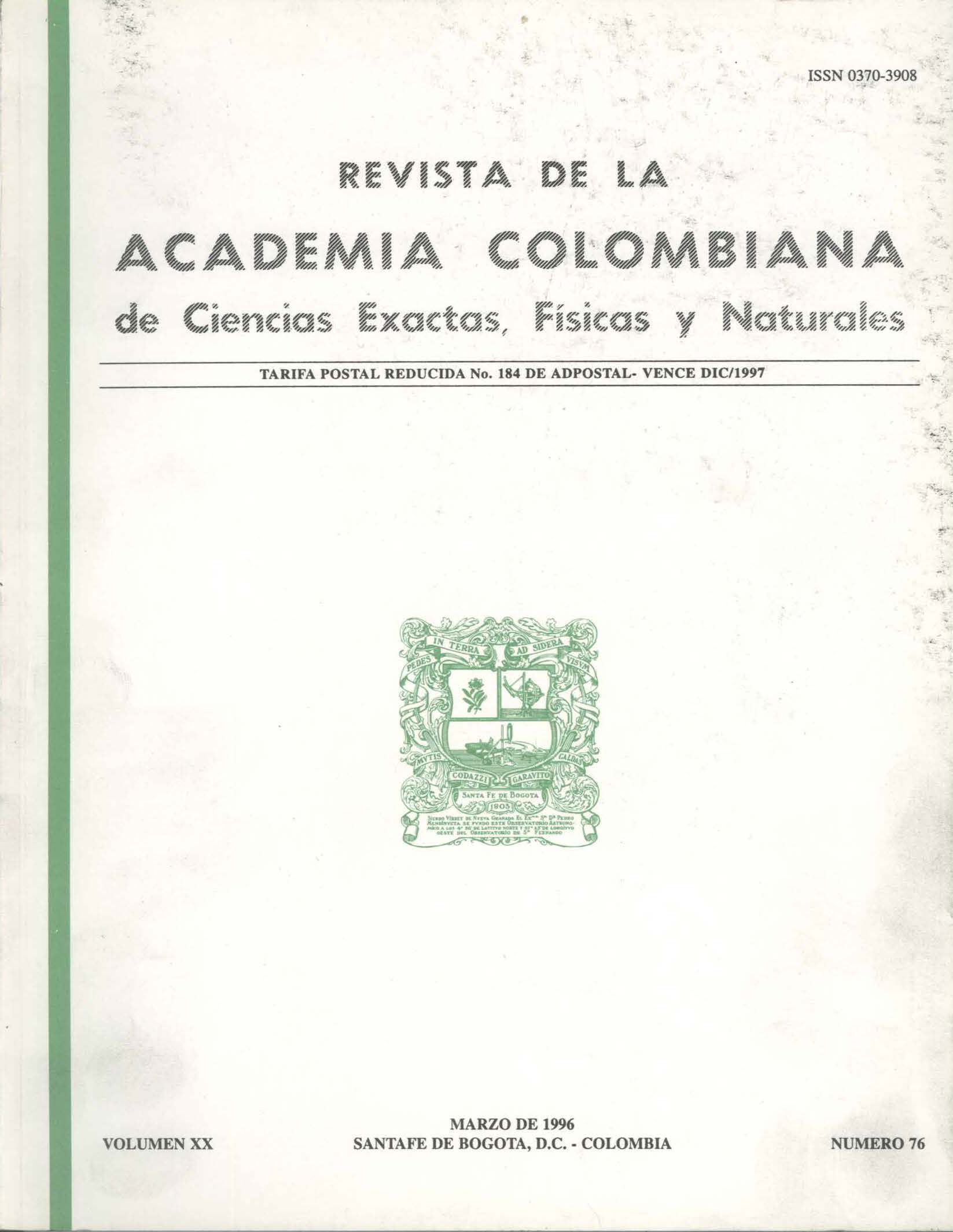Resumen
En 48 localidades, comprendidas entre 1000 y 2300 m alt., ubicadas en la franja subandina del departamento de Cundinamarca, se reconocieron 19 géneros y 62 especies, de Pteridofitos epífítos. El género Polypodium es predominante con 23 especies, que corresponden al 46 % de las registradas para Colombia. Los taxa reconocidos crecen sobre corteza o humus y se desarrollan como holoepífitas (HOE) o epífitas casuales (CAS) sobre hospederos poco específicos. El registro de la distribución geográfica y altitudinal de las especies demuestra mayor diversidad en la vertiente occidental de la cordillera oriental.
Referencias
Atwood, J. T. 1984. A floristic study of Volcán Mombacho, Department of Grenada, Nicaragua. Ann. Missouri Bot. Gard. 71: 141-209.
Benzing, D. H. 1987. Vascular epiphytism: Taxonomic participation and adaptive diversity. Ann. Missouri Bot. Gard. 74: 183-204.
Bop, A. 1992. Composition and distribution of the vascular epiphyte flora of an Ecuadorian montane rain forest. Selbyana 13: 25-34.
Brown, A. D. 1990. El epifitismo en las selvas montanas del parque "El Rey", Argentina: Composición florística y patrón de distribución. Rev. Biol. Trop. 38(2A): 155-166.
Catling, P. M. & L. P. Lefkovitch. 1989. Association of vascular epiphytes in a Guatemalan cloud forest. Biotropica 21: 35-40.
Cuatrecasas, J. 1989. Aspectos de la vegetación natural en Colombia. Pérez Arbelaezia 2(8): 155-283.
Espinal, S. & Montenegro. 1977. Formaciones vegetales de Colombia. Memoria explicativa sobre el mapa ecológico. IGAC, xiii. Bogotá. 238 p.
Evans, A. H. 1969. Interspecific relationships in the Polypodium pectinatum-plumula complex. Ann. Missouri Bot. Gard. 55(3): 193-293.
Gentry, A. H. & C. H. Dodson. 1987. Diversity and biogeography of Neotropical vascular epiphytes. Ann. Missouri Bot. Gard. 74: 205-233.
Grubb, P. J., Lloyd, J. R., Pennington, T. D. & T. C. Whitmore. 1963. A comparison of montane and lowland rain forest in Ecuador. I. The forest structure, physiognomy, and floristics. J. Ecol. 51: 657-601.
Instituto Geográfico Agustín Codazzi (IGAC). 1971. Atlas básico de Colombia, pp. 132-137.
Instituto Geográfico Agustín Codazzi (IGAC). 1986. Diccionario geográfico de Colombia. Tomos I y II. Ed. Andes. Bogotá. pp. 400-401, 787.
Johansson, D. 1974. Ecology of vascular epiphytes in West African rain forest. Acta Phytogeographica Suecica 59: 1-131.
Lewis, W. H. 1971. High floristic endemism in low cloud forests of Panama. Biotropica 31(1): 78-80.
Madison, M. 1977. Vascular epiphytes: Their systematic occurrence and salient features. Selbyana 2: 1-13.
Mickel, J. T. 1981. Ferns and fern allies of Guatemala. Part II. Polypodiaceae. The genus Elaphoglossum. Fieldiana Botany, New Series No. 6: 210-238.
Murillo, M. T. & M. A. Harker. 1990. Helechos y plantas afines de Colombia. Academia Colombiana de Ciencias. Colección Jorge Álvarez Lleras No. 2. Ed. Guadalupe. Bogotá. 319 p.
Nadkarni, N. 1986. An ecological overview and checklist of vascular epiphytes in the Monteverde Cloud Forest Reserve, Costa Rica. Brenesia 24: 55-62.
Ortega, F. 1991. Los helechos. Biollania, Ed. especial No. 2. Talleres Gráficos del Congreso de la República, Caracas, Venezuela. 155 p.
Richards, P. W. 1964. The tropical rain forest: An ecological study. Cambridge University Press.
Schimper, A. F. W. 1888. Die epiphytische Vegetation Amerikas. Bot. Mitt. Tropen. II. G. Fischer Jena.
Smith, A. 1981. Ferns and fern allies of Guatemala. Part II. Polypodiaceae. The genus Thelypteris. Fieldiana Botany, New Series No. 6: 473-514.
Smith, A. 1983. Polypodiaceae-Thelypteridoideae. Flora de Ecuador. 18: 1-147. Publishing House of the Swedish Research Councils. Stockholm, Sweden.
Stolze, G. 1981. Ferns and fern allies of Guatemala. Part II. Polypodiaceae. Fieldiana Botany, New Series 6: 1-120; 238-472.
Stolze, G. 1986. Polypodiaceae-Asplenioideae. En Flora of Ecuador. 23: 1-83. Harling, Gunnar & Benkt Sparre. Stockholm.
Sugden, A. M. & R. J. Robins. 1979. Aspects of the ecology of vascular epiphytes in Colombian cloud forests. I. The distribution of the epiphytic flora. Biotropica 11(3): 173-188.
Ter Steege, H. & J. H. Cornelissen. 1989. Distribution and ecology of vascular epiphytes in lowland rain forest of Guyana. Biotropica 21: 331-339.
Tryon, R. M. & A. T. Tryon. 1982. Ferns and allied plants with special reference to tropical America. Ed. Springer-Verlag. New York. 857 p.
Vareschi, V. 1968. Helechos, Aspleniaceae-Salviniaceae. Flora de Venezuela. Vol. I. Tomo II. Talleres Gráficos Universitarios. Mérida, Venezuela. 1033 p.
Young, K. R. 1991. Floristic diversity on the eastern slopes of the Peruvian Andes. Candollea 46: 125-143.
Zimmerman, J. K. & I. C. Olmstead. 1992. Host tree utilization by vascular epiphytes in a seasonally dry forest (Tintal) in México. Biotropica 24(3): 402-407.

Esta obra está bajo una licencia internacional Creative Commons Atribución-NoComercial-SinDerivadas 4.0.

